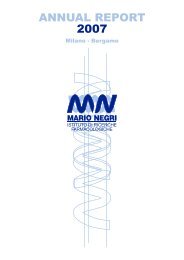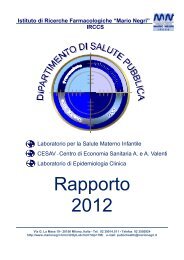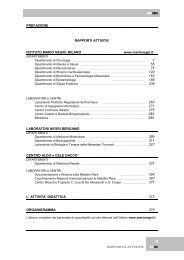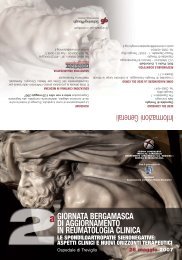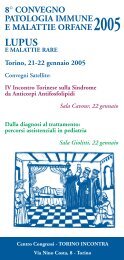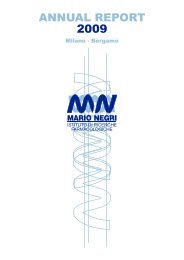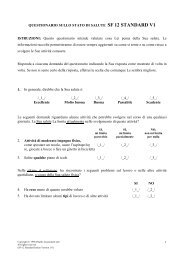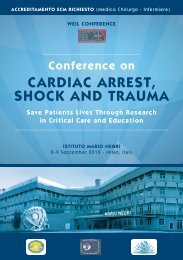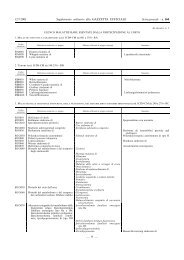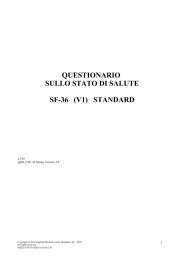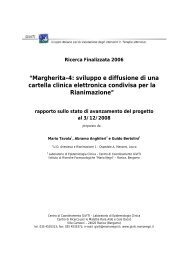Rapporto annuale 2007 - Istituto di Ricerche Farmacologiche Mario ...
Rapporto annuale 2007 - Istituto di Ricerche Farmacologiche Mario ...
Rapporto annuale 2007 - Istituto di Ricerche Farmacologiche Mario ...
You also want an ePaper? Increase the reach of your titles
YUMPU automatically turns print PDFs into web optimized ePapers that Google loves.
IRFMN<br />
Roberto W. Invernizzi ha iniziato la sua carriera scientifica nel 1976 nel laboratorio <strong>di</strong> Neurofarmacologia<br />
dell’<strong>Istituto</strong> <strong>di</strong> <strong>Ricerche</strong> <strong>Farmacologiche</strong> “<strong>Mario</strong> Negri” <strong>di</strong> Milano dove è attualmente responsabile del<br />
Laboratorio <strong>di</strong> Neurochimica e Comportamento. Nel 1986 si è laureato in Scienze Biologiche, presso<br />
l’Università Statale <strong>di</strong> Milano e nel 1996 è stato nominato capo dell’Unità <strong>di</strong> Micro<strong>di</strong>alisi Intracerebrale. Lo<br />
stu<strong>di</strong>o dei meccanismi neurochimici e dei circuiti nervosi coinvolti nella patogenesi delle principali malattie<br />
psichiatriche quali schizofrenia e depressione e del meccanismo d’azione dei farmaci psicotropi costituiscono i<br />
principali interessi del laboratorio. Dal 1987, si è de<strong>di</strong>cato allo sviluppo della tecnica della micro<strong>di</strong>alisi<br />
intracerebrale per lo stu<strong>di</strong>o in vivo del rilascio <strong>di</strong> monoammine. Utilizzando questa tecnica, il gruppo <strong>di</strong><br />
Invernizzi ha contribuito tra i primi a chiarire il ruolo degli autorecettori presinaptici della serotonina e della<br />
noradrenalina negli effetti dei farmaci antidepressivi, suggerendo una nuova ipotesi sul loro meccanismo<br />
d’azione. Attualmente, gli interessi del laboratorio sono rivolti allo stu<strong>di</strong>o dei meccanismi neurochimici coinvolti<br />
nella “resistenza” ai farmaci antidepressivi e al ruolo della trasmissione glutammatergica e serotoninergica<br />
corticale nei processi attenzionali. Revisore per varie riviste internazionali, nel campo della farmacologia e della<br />
neurochimica. Autore e co-autore <strong>di</strong> più <strong>di</strong> 60 articoli con peer-review. Membro della Società Italiana <strong>di</strong><br />
Neuroscienze e della Società Italiana <strong>di</strong> Farmacologia.<br />
Principali pubblicazioni<br />
• Baviera M, Invernizzi RW, Carli M. Haloperidol and clozapine have <strong>di</strong>ssociable effects in a model of attentional<br />
performance deficits induced by blockade of NMDA receptors in the mPFC. Psychopharmacology (Berl) published<br />
online.<br />
• Calcagno E, Canetta A, Guzzetti S, Cervo L, Invernizzi RW. Strain <strong>di</strong>fferences in basal and post-citalopram extracellular<br />
5-HT in the mouse me<strong>di</strong>al prefrontal cortex and dorsal hippocampus: relation with tryptophan with tryptophan<br />
hydroxylase-2 activity. J Neurochem <strong>2007</strong>; 103 : 1111-1120<br />
• Invernizzi RW, Pierucci M, Calcagno E, Di Giovanni G, Di Matteo V, Benigno A, Esposito E. Selective activation of<br />
5HT2C receptors stimulates GABA-ergic function in the rat substantia nigra pars reticulata: a combined in vivo<br />
electrophysiological and neurochemical study. Neuroscience <strong>2007</strong> 144 : 1523-1535<br />
• Carli M, Baviera M, Invernizzi RW, Balducci C Dissociable contribution of 5-HT1A and 5-HT2A receptors in the<br />
me<strong>di</strong>al prefrontal cortex to <strong>di</strong>fferent aspects of executive control such as impulsivity and compulsive perseveration in<br />
rats Neuropsychopharmacology 2006; 31: 757-767<br />
• Calcagno E, Carli M, Invernizzi RW The 5-HT1A receptor agonist 8-OH-DPAT prevents prefrontocortical glutamate<br />
and serotonin release in response to blockade of cortical NMDA receptors J Neurochem 2006; 96: 853-860<br />
• Greco B, Invernizzi RW, Carli M Phencycli<strong>di</strong>ne-induced impairment in attention and response control depends on the<br />
background genotype of mice: reversal by the mGLU2/3 receptor agonist, LY379268 Psychopharmacology (Berl) 2005;<br />
179: 68-76<br />
• Cervo L, Canetta A, Calcagno E, Burbassi S, Sacchetti G, Caccia S, Fracasso C, Albani D, Forloni G, Invernizzi RW<br />
Genotype-dependent activity of tryptophan hydroxylase-2 determines the response to citalopram in a mouse model of<br />
depression J Neurosci 2005; 25: 8165-81<br />
Ugo Lucca ha conseguito il Master of Science presso l'Università <strong>di</strong> Aberdeen (UK) nel 1999. Presso<br />
l'<strong>Istituto</strong> <strong>di</strong> <strong>Ricerche</strong> <strong>Farmacologiche</strong> “<strong>Mario</strong> Negri” è stato ricercatore (1986-1994), poi responsabile<br />
dell'"Unità <strong>di</strong> valutazione Clinica dei Farmaci Antidemenza" (1995-1996) e, dal 1996, è responsabile<br />
del "Laboratorio <strong>di</strong> Neuropsichiatria Geriatrica". Le sue maggiori aree <strong>di</strong> interesse riguardano<br />
l’epidemiologia e gli aspetti clinici della demenza, la storia naturale delle demenze, le malattie<br />
neuropsichiatriche dell’anziano, l’elaborazione <strong>di</strong> strumenti metodologici per lo screening <strong>di</strong>agnostico<br />
e la valutazione dello sviluppo clinico della demenza, la valutazione clinica dei trattamenti antidemenza<br />
e <strong>di</strong> farmaci attivi a livello del sistema nervoso centrale (fase I, II, III e IV e stu<strong>di</strong><br />
osservazionali).<br />
Principali pubblicazioni<br />
• Spagnoli A, Lucca U, Menasce G, Bandera L, Cizza G, Forloni G, Tettamanti M, et al. Long-term acetyl-L-carnitine<br />
treatment in Alzheimer's <strong>di</strong>sease. Neurology 1991; 41:1726-1732<br />
• Lucca U, Comelli M, Tettamanti M, Tiraboschi P, Spagnoli A. Rate of progression and prognostic factors in Alzheimer’s<br />
<strong>di</strong>sease: a prospective study. J Am Geriats Society 1993; 41: 45-49.<br />
• Lucca U, Tettamanti M, Forloni G, Spagnoli A. Nonsteroidal antiinflammatory drug use in Alzheimer’s <strong>di</strong>sease.<br />
Biological Psychiatry 1994; 36: 854-856.<br />
• Imbimbo BP, Martelli P, Troetel WM, Lucchelli F, Lucca U, Thal LJ, and the Eptastigmine Study Group. Efficacy and<br />
safety of eptastigmine for the treatment of patients with Alzheimer’s <strong>di</strong>sease. Neurology 1999; 52: 700-708.<br />
• Quadri P, Fragiacomo C, Pezzati R, Zanda E, Forloni G, Tettamanti M, Lucca U. Homocysteine, folate, and vitamin B-<br />
12 in mild cognitive impairment, Alzheimer’s <strong>di</strong>sease and Vascular Dementia. Am J Clinical Nutr 2004; 80: 114-122.<br />
• Lucca U, Tettamanti M, Quadri P. Homocysteine lowering and cognitive performance. New England Journal of<br />
Me<strong>di</strong>cine 2006; 355: 1390.<br />
74<br />
RAPPORTO ATTIVITA’ <strong>2007</strong>



